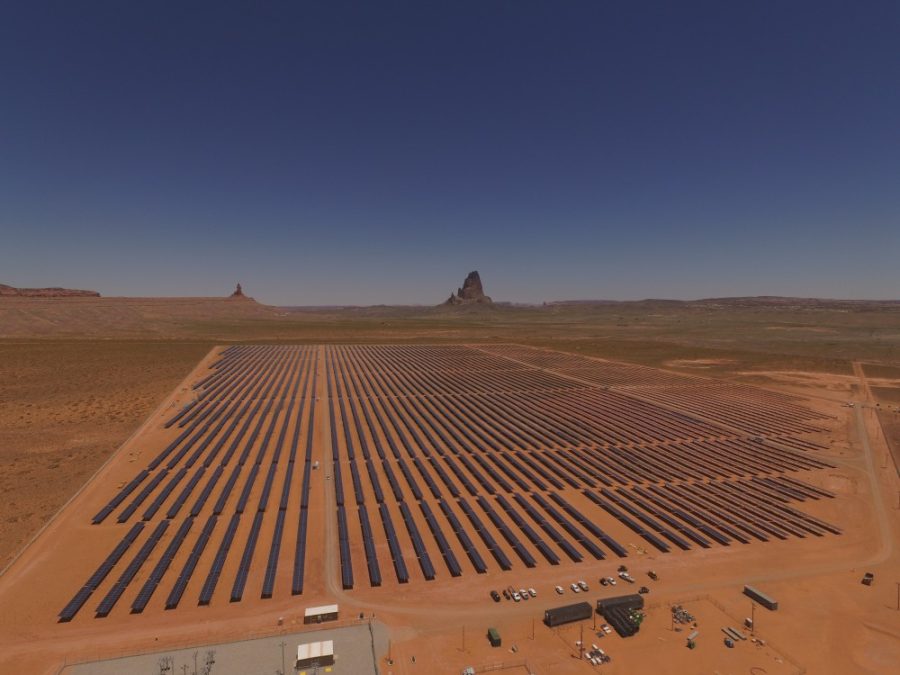The Navajo Nation’s first utility-scale solar plant is now providing sun-powered electricity to area homes.
The 27.3-megawatt project sits on 300acres in Kayenta, a Navajo community south of Monument Valley, Arizona.
The Kayenta Solar Facility, built by the Navajo Tribal Utility Authority, was the final form of a longtime desire, according to NTUA government and public affairs manager Deenise Becenti.
“It’s been a goal that we’ve had for over 10 years — not this exact facility, but in terms of that we’ve always had a goal of moving into renewable energy development,” Becenti said.
Comprised of 119,301 photovoltaic panels set on single-axis trackers that move with the sun, the facility is more than just numbers to Becenti.
“Right now, the facility, we see it as a signification demonstration that renewable energy facilities can be built here in Navajo,” Becenti said. “So the long term goal, our hope, is that we can establish a green economy here on Navajo.”
A green energy economy would mean communities outside the Navajo Nation would purchase power generated from its project. NTUA usually purchases power from places like Tucson Electric Power and the Public Service Company of New Mexico.
RELATED: UA hosts community teach in on South Tucson water contamination
That purchased power is distributed to NTUA substations and then to the homes the enterprise services. Now, that energy is being supplemented via the Kayenta Solar Facility.
“Right now, all the energy produced is being used here on Navajo land, feeding our two major substations,” Becenti said. “So anyone who uses that grid right now, they’re taking some of the solar power being generated.”
Ron Trosper, a University of Arizona American Indian Studies professor, said NTUA’s move into green energy generation is a return to the way electricity utilities used to be: with both distribution and generation under the same enterprise.
“They grew up integrated, where they were generating and distributing,” Trosper said. “It was only in recent years that they were encouraged to separate.”
Trosper said the expansion of NTUA’s function is not only a driver of economic development, but a result of it.
“That’s one aspect of economic development that’s going on, it’s [NTUA] becoming a bigger, more diverse entity,” Trosper said.
Another benefit of a green energy economy would be the added revenue, according to Becenti.
“We could use the money generated by sales to continue to build homes that are currently without electricity,” Becenti said. “We estimate that there are 15,000 homes within our service territory without electricity.”
RELATED: Here’s how to have a sustainable semester
Trosper said that while the sheer size of the Navajo Nation can make electricity distribution difficult and expensive, Navajo has “lots of wind and lots of sunlight,” which could reduce costs in the long run.
“Navajo is a big, spread-out community where having access to electricity — good, well-priced electricity — is important to community welfare,” Trosper said.
This first solar plant has the potential to boost the economy and improve lives in other ways, too. Becenti said the building process, which lasted six months and cost $60 million, employed close to 250 people, and nearly 200 were Navajo.
“This project provided enough training to give our people a resume in the construction of a solar facility,” Becenti said. “If we are able to get another project underway, we know we do have a workforce in Navajo that is ready to go.”
NTUA hopes to build more, according to Becenti.
“Our goal is to look to other communities to see if they would allow us to build within their regions,” Becenti said. “The largest challenge for us is to find enough land to build a facility of this size.”

Trosper said he liked the idea of involving community members in the build.
“That was a good thing to do, and will help other communities, because having people getting into the green energy sector is the wave of the future,” Trosper said.
With many tribes interested in alternative energy sources, Trosper said projects like the Kayenta Solar Facility are likely a growing trend.
“There is a small movement among tribes to take over the distribution of electricity on their reservation, and a few who have done it,” Trosper said. “Those tribes would be the ones who would probably be first in line looking at new generation sources.”
Becenti said the project was a multi-partnership accomplishment, involving the support of the Navajo Nation and the Kayenta community and partners like the Salt River Project, with which NTUA has a two-year power purchase and renewable energy credit agreement to cover loan repayments for the facility’s construction.
“For [the partnerships and support] we are certainly thankful,” Becenti said. “We certainly welcome other nations to visit the site and to see that yes, a facility can be built within their own homeland.”









